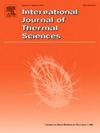Research on the influence of structural parameters and optimization of heat sinks for high-power helicopter intermediate gearboxes
IF 5
2区 工程技术
Q1 ENGINEERING, MECHANICAL
International Journal of Thermal Sciences
Pub Date : 2025-08-25
DOI:10.1016/j.ijthermalsci.2025.110237
引用次数: 0
Abstract
The intermediate gearbox of high-power helicopters needs to withstand higher loads and greater heat dissipation requirements. Relying solely on the casing shell for heat dissipation can no longer meet its cooling demands, necessitating the addition of heat sinks on the casing surface to enhance heat transfer capability. This study simplifies the high-temperature surface of the intermediate gearbox casing into a flat plate of uniform thickness and investigates the influence of heat sink structure on the plate's cooling capacity through experimental and numerical simulation methods. Using CFD simulation and infrared thermography, the simulation results were compared with experimental data, revealing an average error of 1.01 %, which verifies the accuracy of the CFD simulation and confirms the V-shaped heat sink as the optimal configuration. Analysis of the effects of heat sink height, width, spacing, and width-to-spacing ratio shows that increasing height improves heat transfer performance by 12.9 %, increasing width reduces it by 12.2 %, increasing spacing improves it by 13.6 %, and increasing the width-to-spacing ratio decreases it by 27.3 %. When the optimized heat sink parameters were applied to the bottom casing of a certain high-power helicopter intermediate gearbox, temperature field simulations demonstrated that the optimized heat sinks reduced the maximum temperature at the casing bottom by 14.7K and the oil temperature by 5.8K.
大功率直升机中间齿轮箱散热器结构参数影响及优化研究
大功率直升机的中间齿轮箱需要承受更高的载荷和更大的散热要求。单纯依靠机匣外壳散热已不能满足其散热需求,需要在机匣表面增设散热器来增强换热能力。本研究将中间齿轮箱箱体的高温表面简化为均匀厚度的平板,并通过实验和数值模拟的方法研究了散热器结构对平板冷却能力的影响。利用CFD模拟和红外热像仪将模拟结果与实验数据进行对比,平均误差为1.01%,验证了CFD模拟的准确性,确定了v型散热器为最优散热结构。对散热器高度、宽度、间距和宽间距比的影响分析表明,增加高度可使传热性能提高12.9%,增加宽度可使传热性能降低12.2%,增加间距可使传热性能提高13.6%,增加宽间距比可使传热性能降低27.3%。将优化后的散热器参数应用于某大功率直升机中间齿轮箱底部机匣,温度场仿真结果表明,优化后的散热器使机匣底部最高温度降低14.7K,油温降低5.8K。
本文章由计算机程序翻译,如有差异,请以英文原文为准。
求助全文
约1分钟内获得全文
求助全文
来源期刊

International Journal of Thermal Sciences
工程技术-工程:机械
CiteScore
8.10
自引率
11.10%
发文量
531
审稿时长
55 days
期刊介绍:
The International Journal of Thermal Sciences is a journal devoted to the publication of fundamental studies on the physics of transfer processes in general, with an emphasis on thermal aspects and also applied research on various processes, energy systems and the environment. Articles are published in English and French, and are subject to peer review.
The fundamental subjects considered within the scope of the journal are:
* Heat and relevant mass transfer at all scales (nano, micro and macro) and in all types of material (heterogeneous, composites, biological,...) and fluid flow
* Forced, natural or mixed convection in reactive or non-reactive media
* Single or multi–phase fluid flow with or without phase change
* Near–and far–field radiative heat transfer
* Combined modes of heat transfer in complex systems (for example, plasmas, biological, geological,...)
* Multiscale modelling
The applied research topics include:
* Heat exchangers, heat pipes, cooling processes
* Transport phenomena taking place in industrial processes (chemical, food and agricultural, metallurgical, space and aeronautical, automobile industries)
* Nano–and micro–technology for energy, space, biosystems and devices
* Heat transport analysis in advanced systems
* Impact of energy–related processes on environment, and emerging energy systems
The study of thermophysical properties of materials and fluids, thermal measurement techniques, inverse methods, and the developments of experimental methods are within the scope of the International Journal of Thermal Sciences which also covers the modelling, and numerical methods applied to thermal transfer.
 求助内容:
求助内容: 应助结果提醒方式:
应助结果提醒方式:


